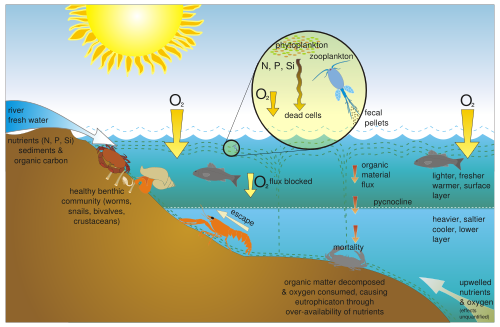Eutrophication
Eutrophication is an important process involving enrichment of water by excess nutrients. The different processes and effects of coastal eutrophication are well documented (Cloern, 2001[1] ; Conley et al., 2002[2] ; Rönnberg and Bonsdorff, 2004[3]). and it has been considered as one of the biggest threats to marinne ecosystem health for decades (Ryther and Dunstan, 1971[4] ; Nixon, 1995[5]; Elmgren, 2001[6] ; Bachmann et al., 2006[7].
Contents
What is eutrophication about?
- It’s about increased productivity (conversion of light and carbon dioxide into living organic matter – a process being limited by nitrogen and/or phosphorus)
and unacceptable ecological effects as algal blooms, oxygen depletion, kills of benthic animals and fish
- It’s caused by increased inputs of nutrients from
- point sources
- activities in the upstream catchment (e.g. losses from agriculture)
- atmospheric deposition
- It’s about money!
But is “eutrophication” good?
- In general: NO … it is actually ”bad” …
- ... too many nutrients in wrong places may cause problems and result in changes
in structure, function and stability of the marine ecosystems …
- Eutrophication is ”too much of a good thing”
What are we really talking about?
- Eutrophication
- “eu” = “well” or “good”
- “trope” = “nourishment”
Some definitions:
- Eutrophication
- An increase in the supply of organic matter (Nixon 1995[8])
- A condition in an aquatic ecosystem where high nutrient concentrations stimulate growth of algae which leads to imbalanced functioning of the system” (HELCOM)[9].
- Alternative proposal
- The enrichment of water by nutrients, especially nitrogen and/or phosphorus and organic matter, causing an increased growth of algae and higher forms of plant life to produce an unacceptable deviation in structure, function and stability of organisms present in the water and to the quality of water concerned, compared to reference conditions (Andersen et al. (2006)[10])
The process of eutrophication
Eutrophication schematic. Source: US EPA
European Coastal Areas
The main source of nitrogen to European coastal waters is agricultural runoff discharged into the sea via rivers, identified as originating from sources of ammonia evaporation in animal husbandry and partly from fossil fuel combustion in traffic, industry and households (EEA Topic report 7/2001[11]). For phosphorus the major sources are treated and untreated discharges to the sea from households and industry as well as soil erosion (EEA Topic report 7/2001[12]).
EU Directives:
- EC Urban Waster Water Treatment Directive http://ec.europa.eu/environment/water/water-urbanwaste/directiv.html
- EC Nitrates Directive http://ec.europa.eu/environment/water/water-nitrates/directiv.html
- EU Water Framework Directive http://ec.europa.eu/environment/water/water-framework/index_en.html
- Marine Strategy Directive http://ec.europa.eu/environment/water/marine.html
See also
External links
- National environment research institute (DK)DMU
- BERNET: Baltic Eutrophication Regional Network [1]
- (Source appointments of nitrogen and phosphorus inputs into the aquatic environment: article not referenced (and not allowed to reproduce)
http://reports.eea.europa.eu/eea_report_2005_7/en/EEA_report_7_2005.pdf)
References
- ↑ Cloern, J. (2001) Our evolving conceptual model of the coastal eutrophication problem. Mar. Ecol. Prog. Ser., 210, 223–253.[ISI]
- ↑ Conley, D. J., Markager, S., Andersen, J. et al. (2002) Coastal eutrophication and the Danish National Aquatic Monitoring and Assessment Program. Estuaries, 25, 706–719.[Medline]
- ↑ Rönnberg, C. and Bonsdorff, E. (2004) Baltic Sea eutrophication: area-specific ecological consequences. Hydrobiologia, 514, 227–241.[CrossRef][ISI]
- ↑ Ryther and Dunstan, 1971
- ↑ Nixon, S. W. (1995) Coastal marine eutrophication: a definition, social causes, and future concerns. Ophelia, 41, 199–219.[ISI]
- ↑ NEED REF
- ↑ Bachmann, R. W., Cloern, J. E., Heckey, R. E. et al. (eds) (2006) Eutrophication of freshwater and marine ecosystems. Limnol. Oceanogr., 51 (1, part 2), 351–800.
- ↑ Nixon, S. W. (1995) Coastal marine eutrophication: a definition, social causes, and future concerns. Ophelia, 41, 199–219.[ISI]
- ↑ http://www.helcom.fi/environment2/eutrophication/en_GB/front/
- ↑ Andersen, J. H., Schlüter, L. and Ærtebjerg, G. (2006) Coastal eutrophication: recent developments in definitions and implications for monitoring strategies. J. Plankton Res. 28(7): 621-628.
- ↑ Ærtebjerg, G. et al., Eutrophication in Europe’s Coastal Waters. Topic Report No 7/2001. European Environment Agency. (http://reports.eea.europa.eu/topic_report_2001_7/en)
- ↑ Ærtebjerg, G. et al., Eutrophication in Europe’s Coastal Waters. Topic Report No 7/2001. European Environment Agency. (http://reports.eea.europa.eu/topic_report_2001_7/en)
Authorship
02/01/2007, Karen Edelvang (kae@dhigroup.com) Caitlin Pilkington (caitlin.pilkington@gmail.com), DHI Water Environment Health.
